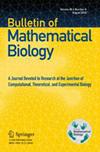0-1 Laws for Pattern Occurrences in Phylogenetic Trees and Networks.
IF 2
4区 数学
Q2 BIOLOGY
引用次数: 0
Abstract
In a recent paper, the question of determining the fraction of binary trees that contain a fixed pattern known as the snowflake was posed. We show that this fraction goes to 1, providing two very different proofs: a purely combinatorial one that is quantitative and specific to this problem; and a proof using branching process techniques that is less explicit, but also much more general, as it applies to any fixed patterns and can be extended to other trees and networks. In particular, it follows immediately from our second proof that the fraction of d-ary trees (resp. level-k networks) that contain a fixed d-ary tree (resp. level-k network) tends to 1 as the number of leaves grows.

系统树和网络中模式出现的 0-1 规律。
在最近的一篇论文中,我们提出了一个问题:如何确定二叉树中包含固定图案(即雪花)的部分。我们证明了这个分数为 1,并提供了两个截然不同的证明:一个是纯粹的组合证明,它是定量的,专门针对这个问题;另一个是使用分支过程技术的证明,它不那么明确,但也更通用,因为它适用于任何固定模式,并可扩展到其他树和网络。特别是,从我们的第二个证明可以立即看出,随着树叶数量的增加,包含固定 dary 树(或 k 级网络)的 dary 树(或 k 级网络)的分数趋向于 1。
本文章由计算机程序翻译,如有差异,请以英文原文为准。
求助全文
约1分钟内获得全文
求助全文
来源期刊
CiteScore
3.90
自引率
8.60%
发文量
123
审稿时长
7.5 months
期刊介绍:
The Bulletin of Mathematical Biology, the official journal of the Society for Mathematical Biology, disseminates original research findings and other information relevant to the interface of biology and the mathematical sciences. Contributions should have relevance to both fields. In order to accommodate the broad scope of new developments, the journal accepts a variety of contributions, including:
Original research articles focused on new biological insights gained with the help of tools from the mathematical sciences or new mathematical tools and methods with demonstrated applicability to biological investigations
Research in mathematical biology education
Reviews
Commentaries
Perspectives, and contributions that discuss issues important to the profession
All contributions are peer-reviewed.

 求助内容:
求助内容: 应助结果提醒方式:
应助结果提醒方式:


